- Home
- Peter Tremayne
Whispers of the Dead
Whispers of the Dead Read online
WHISPERS
OF THE DEAD
BY PETER TREMAYNE AND FEATURING
SISTER FIDELMA
Absolution by Murder
Shroud for the Archbishop
Suffer Little Children
The Subtle Serpent
The Spider’s Web
Hemlock at Vespers
Valley of the Shadow
The Monk Who Vanished
Act of Mercy
Our Lady of Darkness
Smoke in the Wind
The Haunted Abbot
Badger’s Moon*
*forthcoming
PETER TREMAYNE
WHISPERS
OF THE DEAD
Fifteen Sister Fidelma Mysteries
St. Martin’s Minotaur
New York
For the wonderfully supportive members of
The International Sister Fidelma Society,
with gratitude
WHISPERS OF THE DEAD. Copyright © 2004 by Peter Tremayne. All rights reserved. Printed in the United States of America. No part of this book may be used or reproduced in any manner whatsoever without written permission except in the case of brief quotations embodied in critical articles or reviews. For information, address St. Martin’s Press, 175 Fifth Avenue, New York, N.Y. 10010.
www.minotaurbooks.com
Design by Kathryn Parise
LIBRARY OF CONGRESS CATALOGING-IN-PUBLICATION DATA
Tremayne, Peter.
Whispers of the dead : fifteen Sister Fidelma mysteries / Peter
Tremayne.—1st ed.
p. cm.
ISBN 0-312-30382-3
EAN 978-0312-30382-2
1. Fidelma, Sister (Fictitious character)—Fiction. 2. Ireland—
History—To 1172—Fiction. 3. Women detectives—Ireland—Fiction.
4. Detective and mystery stories, English. 5. Historical fiction, English.
6. Nuns—Fiction. I. Title.
PR6 070.R366W47 2004
823'.914—dc22
2003070096
First Edition: May 2004
10 9 8 7 6 5 4 3 2 1
CONTENTS
Introduction
Whispers of the Dead
Corpse on a Holy Day
The Astrologer Who Predicted His Own Murder
The Blemish
Dark Moon Rising
Like a Dog Returning . . .
The Banshee
The Heir-Apparent
Who Stole the Fish?
Cry “Wolf!”
Scattered Thorns
Gold at Night
Death of an Icon
The Fosterer
The Lost Eagle
Acknowledgments
About the Author
INTRODUCTION
Welcome to the second volume of Sister Fidelma short mystery stories. The Sister Fidelma mysteries are set during the seventh century A.D., mainly in her native Ireland.
Sister Fidelma is not simply a religieuse. She is, indeed, a member of what we now call the Celtic Church, whose conflicts with Rome on matters of theology and social governance are well known. As well as the differences in rituals, the dating of Easter and the wearing of a dissimilar tonsure, celibacy was not widely practiced and many religious houses contained individuals of both sexes who raised their children to the continued service of God. However, Fidelma is basically a qualified dálaigh, an advocate of the seventh-century law courts of Ireland, and using the ancient Brehon Law system. In those days women were co-equal with men and could aspire to all the professions. Many women were lawyers and judges and wrote law texts as well as interpreted them. Indeed, we even know the names of many of them.
Those who have followed Sister Fidelma’s adventures in the series of novels and in the previous volume of short stories, Hemlock at Vespers, will no doubt be acquainted with the historical and social background to these stories. Those volumes contain an explanatory “Historical Note.” Such background details have also been put on the amazing International Sister Fidelma Society Web site at www.sisterfidelma.com and I feel it is superfluous to add it to this volume.
In these short stories, as with the previous fifteen tales collected in Hemlock at Vespers, Fidelma usually appears without her companion, the Irish-trained Saxon Brother Eadulf of Seaxmund’s Ham, from the land of the South Folk. There is an exception in this volume. “The Lost Eagle” features Brother Eadulf because it is an event that occurs while Sister Fidelma is visiting Canterbury with him, and chronologically occurring between the events in the novels Smoke in the Wind and The Haunted Abbot. Every other tale is set in Ireland.
In Fidelma’s own chronology, “The Blemish” is the earliest story because it occurs while she is still studying law under the Brehon Morann at his law school. The bulk of these stories have been written at the request of editors who sought particular themes, such as my good friend Peter Haining, who wanted to know if Fidelma would be adverse to appearing in a drinking story. “Gold at Night” was the inevitable outcome. Another editor wanted to know if Fidelma ever took a vacation, or what passed as a vacation for a seventh-century A.D. religieuse. “Corpse on a Holy Day” was the response. Now and then references have been made in the stories to Fidelma’s interest in cosmology and astrology. Astrology was an art widely practiced in those days. An editor asked me to expand on that and thus we have “The Astrologer Who Predicted His Own Murder.”
With the demand for Fidelma short stories from various quarters, David R. Wooten, the energetic and creative editor of The Brehon, the journal of The International Sister Fidelma Society, approached me. The Society produces The Brehon three times a year for its members. With such support and a membership spanning many countries, I decided that The Brehon should have the opportunity of publishing some original Fidelma stories and “The Blemish” and “Dark Moon Rising” first appeared in its columns.
When my editors asked me if I would consider putting together a second volume of short stories, they also asked me if I could add a couple of original tales on aspects of Brehon Law, which I had not covered in previous stories. For example, how was an Irish Chief elected? That is the theme of “The Heir-Apparent.” What was “foster-age” in ancient Ireland and were there laws to protect children? Hence—“The Fosterer.” And also, of the complicated subject of inheritance from a person deemed to be insane, “Cry Wolf!” is one aspect.
In the short stories, a character for whom I have a fondness has appeared several times: Abbot Laisran of Durrow, County Laois (from Dearmach in Middle Irish or Darú in Modern Irish, which means “the oak plain”). The abbey was founded by St. Colmcille before his exile from Ireland circa A.D. 563. Durrow was one of the most important ecclesiastical teaching centers in Ireland and in the mid-seventh century, during Fidelma’s day, it is recorded that its students came from no less than eighteen different nations in Europe. Today, Durrow is best remembered for its famous illustrated Gospel book, The Book of Durrow, dated by some to the mid seventh-century.
Abbot Laisran regards Fidelma as his protégée. It was he who persuaded her, once she had qualified in Brehon Morann’s law school to the level of anruth, one degree below the highest that the secular and ecclesiastical colleges of ancient Ireland could bestow, to join the abbey of Kildare. As many readers will know, Fidelma is more concerned with law than religion and when she found out that her abbess was not averse to breaking the law, she left Kildare (see the story “Hemlock at Vespers” in the collection of the same name). For a base, she returned to the court of her brother, Colgú, King of Muman, who ruled at Cashel, in what is now County Tipperary.
In stories such as “A Canticle for Wulfstan” and “The Horse that Died for Shame” (collected in Hemlock at Vespers) Abbot Laisra
n’s good humor acts as a balance to Fidelma’s sterner thoughts of duty and the search for truth. I have received not a few letters from readers asking why I did not bring the good Abbot Laisran into more of Fidelma’s adventures. Those readers will, I hope, be pleased to know that Abbot Laisran appears in the title story “Whispers of the Dead,” “Who Stole the Fish?,” and in “Gold at Night.”
Here, then, are another fifteen mysteries that try Fidelma’s abilities to the limit. As in some of the earlier mysteries, Fidelma, and you, will discover—as in “The Fosterer”—that law is not always synonymous with justice.
WHISPERS
OF THE DEAD
WHISPERS OF THE DEAD
Abbot Laisran sat back in his chair, at the side of the crackling log fire, and gazed thoughtfully at his cup of mulled wine.
“You have achieved a formidable reputation, Fidelma,” he observed, raising his cherub-like features to his young protégée, who sat on the other side of the fireplace, sipping her wine. “Some Brehons talk of you as they would the great female judges such as Brig or Dari. That is commendable in one so young.”
Fidelma smiled thinly. She was not one given to vanity for she knew her own weaknesses.
“I would not aspire to write legal texts as they did, nor, indeed, would I pretend to be more than a simple investigator of facts. I am a dálaigh, an advocate. I prefer to leave the judgment of others to the Brehons.”
Abbot Laisran inclined his head slightly as if in acceptance of her statement.
“But that is the very thing on which your reputation has its foundation. You have had some outstanding successes with your investigations, observing things that are missed by others. Several times I have seen your ability firsthand. Does it ever worry you that you hold so much responsibility?”
“It worries me only that I observe all the facts and come to the right decision. However, I did not spend eight years under instruction with the Brehon Morann of Tara to no avail. I have come to accept the responsibility that goes with my office.”
“Ah,” sighed the abbot. “‘Unto whomsoever much is given, of him shall much be required.’ That is from—”
“The Gospel of Luke,” Fidelma interrupted with a mischievous smile.
Abbot Laisran answered her smile.
“Does nothing escape your attention, Fidelma? Surely there must be cases when you are baffled? For instance, there must be many a murder over which it is impossible to attribute guilt.”
“Perhaps I have been lucky,” admitted Fidelma. “However, I do not believe that there is such a thing as a perfect crime.”
“Come now, that must be an overstatement?”
“Even when we examine a body with no evidence of who he, or she, was in life, or how and when he, or she, died, let alone by whose hand, a good observer will learn something. The dead always whisper to us. It is our task to listen to the whispers of the dead.”
The abbot knew it was not in Fidelma’s nature to boast of her prowess; however, his round features assumed a skeptical expression.
“I would like to make a wager with you,” he suddenly announced.
Fidelma frowned. She knew that Abbot Laisran was a man who was quick to place wagers. Many was the time she had attended the great Aenach Lifé, the fair at the Curragh, for the horseracing and watched Abbot Laisran losing as well as winning as he hazarded money on the contests.
“What manner of wager had you in mind, Laisran?” she asked cautiously.
“You have said that the dead whisper to us and we must have ears to listen. That in every circumstance the body of a person will eventually yield up the information necessary to identify him, and who, if anyone, is culpable for the death. Have I understood you correctly?”
Fidelma inclined her head in agreement.
“That has been my experience until now,” she conceded.
“Well then,” continued Abbot Laisran, “will you take a wager with me on a demonstration of that claim?”
“In what circumstances?”
“Simple enough. By coincidence, this morning a young peasant woman was found dead not far from this abbey. There was no means of identification on her and inquiries in the adjacent village have failed to identify her. No one appears to be missing. She must have been a poor itinerant. One of our brothers, out of charity, brought the body to the abbey. Tomorrow, as is custom, we shall bury her in an unmarked grave.” Abbot Laisran paused and glanced slyly at her. “If the dead truly whisper to you, Fidelma, perhaps you will be able to interpret those whispers and identify her?”
Fidelma considered for a moment.
“You say that she was a young woman? What was the cause of her death?”
“That is the mystery. There are no visible means of how she died. She was well nourished, according to our apothecary.”
“No signs of violence?” asked Fidelma, slightly bemused.
“None. The matter is a total mystery. Hence I would place a wager with you, which is that if you can find some evidence, some cause of death, of something that will lead to the identification of the poor unfortunate, then I will accept that your claim is valid. So, what of the wager?”
Fidelma hesitated. She disliked challenges to her abilities but, on the other hand, some narcissistic voice called from within her.
“What is the specific wager?” she asked.
“A screpall for the offertory box of the abbey.” Abbot Laisran smiled. “I will give a screpall for the poor if you can discover more about the poor woman than we have been able to. If you cannot, then you will pay a screpall to the offertory box.”
A screpall was a silver coin valued to the fee charged by a dálaigh for a single consultation.
Fidelma hesitated a moment and then, urged on by her pride, said: “It is agreed.”
She rose and set down her mulled wine, startling the abbot.
“Where are you going?” he demanded.
“Why, to view the body. There is only an hour or two of daylight left, and many important signs can vanish in artificial light.”
Reluctantly, Abbot Laisran set down his wine and also rose.
“Very well,” he sighed. “Come, I will show you the way to the apothecary.”
A tall, thin religieux with a beak of a nose glanced up as Abbot Laisran entered the chamber where he was pounding leaves with a pestle. His eyes widened a little when he saw Sister Fidelma enter behind the abbot. Fidelma was well known to most of the religious of the Abbey of Durrow.
“Brother Donngal, I have asked Sister Fidelma to examine our unknown corpse.”
The abbey’s apothecary immediately set aside his work and gazed at her with interest.
“Do you think that you know the poor woman, Sister?”
Fidelma smiled quickly.
“I am here as a dálaigh, Brother,” she replied.
A slight frown crossed Brother Donngal’s features.
“There is no sign of a violent death, Sister. Why would an advocate have an interest in this matter?”
Catching the irritable hardening of her expression, Abbot Laisran intervened quickly: “It is because I asked Sister Fidelma to give me her opinion on this matter.”
Brother Donngal turned to a door.
“The body lies in our mortuary. I was shortly to prepare it for burial. Our carpenter has only just delivered the coffin.”
The body lay under a linen sheet on a table in the center of the chamber that served as the abbey’s mortuary where bodies were prepared for burial.
Sister Fidelma moved toward it and was about to take a corner of the sheet in her hand when the apothecary coughed apologetically.
“I have removed her clothing for examination but have not dressed her for the coffin yet, Sister.”
Fidelma’s eyes twinkled at the man’s embarrassment, but she made no reply.
The corpse was that of a young woman, perhaps no more than twenty years old. Fidelma had not entirely hardened herself to premature death.
“She is not lo
ng dead,” was Fidelma’s first remark.
Brother Donngal nodded.
“No more than a day and a night, I reckon. She was found this morning and I believe she died during the night.”
“By whom was she found?”
“Brother Torcan,” intervened Abbot Laisran, who was standing just inside the door observing them.
“Where was she found?”
“No more than a few hundred paces from the abbey walls.”
“I meant, in what place, what were the conditions of her surroundings?”
“Oh, I see. She was found in a wood, in a small clearing almost covered with leaves.”
Fidelma raised an eyebrow.
“What was this Brother Torcan doing there?”
“Gathering edible fungi. He works in the kitchens.”
“And the clothes worn by the girl . . . where are they?” Fidelma asked.
The man gestured to a side table on which clothing was piled.
“She wore just the simple garb of a village girl. There is nothing to identify her there.”
“I will examine them in a moment and likewise will wish to speak to this Brother Torcan.”
She turned her gaze back to the body, bending forward to examine it with careful precision.
It was some time before she straightened from her task.
“Now, I shall examine the clothing.”
Brother Donngal moved to a table and watched while Fidelma picked up the items. They consisted of a pair of sandals called cuaran, a single sole of untanned hide, stitched together with thongs cut from the same hide. They were almost worn through. The dress was a simple one of wool and linen, roughly woven and threadbare. It appeared to have been secured at the waist by a strip of linen. There was also a short cape with a hood, as affected by many country women. Again, it was obviously worn, and fringed with rabbit fur.

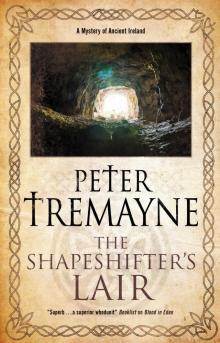 The Shapeshifter's Lair
The Shapeshifter's Lair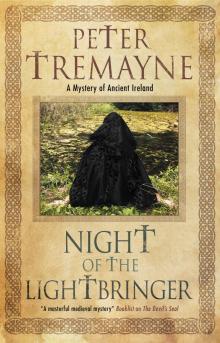 Night of the Lightbringer
Night of the Lightbringer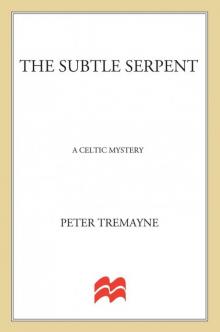 The Subtle Serpent
The Subtle Serpent Smoke in the Wind
Smoke in the Wind Island of Shadows
Island of Shadows The Morgow Rises!
The Morgow Rises! A Prayer for the Damned sf-17
A Prayer for the Damned sf-17 Behold a Pale Horse
Behold a Pale Horse Shroud for the Archbishop
Shroud for the Archbishop The Banshee (sister fidelma)
The Banshee (sister fidelma) The Curse of Loch Ness
The Curse of Loch Ness Whispers of the Dead
Whispers of the Dead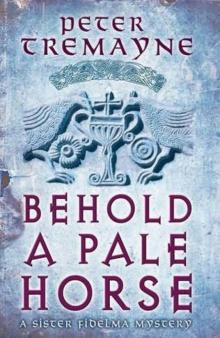 Behold a Pale Horse sf-22
Behold a Pale Horse sf-22 Suffer Little Children
Suffer Little Children The Spider's Web
The Spider's Web Sanctuary (sister fidelma)
Sanctuary (sister fidelma)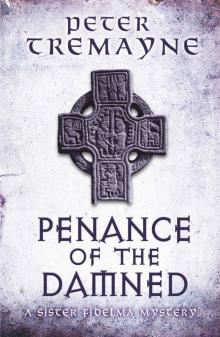 Penance of the Damned (Sister Fidelma)
Penance of the Damned (Sister Fidelma) Absolution by Murder
Absolution by Murder A Scream From The Sepulchre
A Scream From The Sepulchre The Dove of Death sf-20
The Dove of Death sf-20 Absolution by Murder sf-1
Absolution by Murder sf-1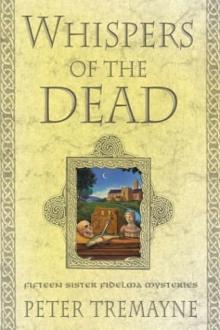 Whispers of the Dead sf-15
Whispers of the Dead sf-15 The Subtle Serpent sf-4
The Subtle Serpent sf-4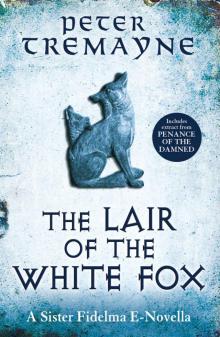 The Lair of the White Fox (e-novella) (Kindle Single)
The Lair of the White Fox (e-novella) (Kindle Single)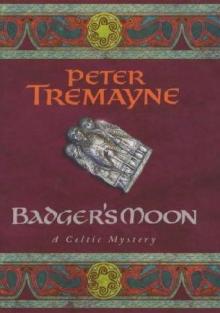 Badger's Moon sf-13
Badger's Moon sf-13 The Monk Who Vanished
The Monk Who Vanished Master of Souls sf-16
Master of Souls sf-16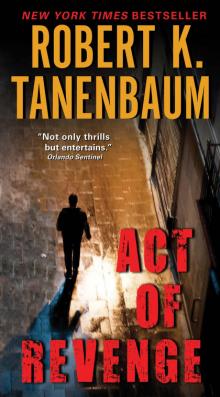 Act of Mercy sf-8
Act of Mercy sf-8 Valley of the Shadow
Valley of the Shadow Act of Mercy
Act of Mercy Dancing With Demons sf-18
Dancing With Demons sf-18 Suffer Little Children sf-3
Suffer Little Children sf-3 The Leper's Bell
The Leper's Bell Master of Souls
Master of Souls Hemlock at Vespers sf-9
Hemlock at Vespers sf-9 The Haunted Abbot sf-12
The Haunted Abbot sf-12 23- The Seventh Trumpet
23- The Seventh Trumpet The Spider's Web sf-5
The Spider's Web sf-5 Valley of the Shadow sf-6
Valley of the Shadow sf-6 Bloodmoon
Bloodmoon Hemlock at Vespers: Fifteen Sister Fidelma Mysteries
Hemlock at Vespers: Fifteen Sister Fidelma Mysteries The Council of the Cursed
The Council of the Cursed The Dove of Death
The Dove of Death The Leper's bell sf-14
The Leper's bell sf-14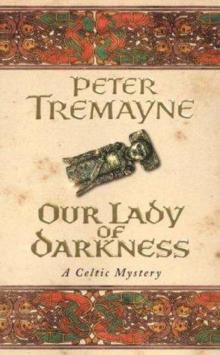 Our Lady of Darkness sf-10
Our Lady of Darkness sf-10 The Council of the Cursed sf-19
The Council of the Cursed sf-19 The Second Death (Sister Fidelma Mysteries)
The Second Death (Sister Fidelma Mysteries) The Fiery Devil
The Fiery Devil Dancing With Demons
Dancing With Demons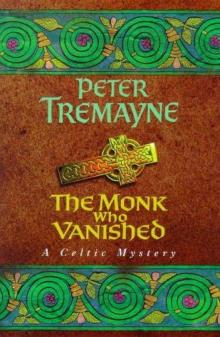 The Monk Who Vanished sf-7
The Monk Who Vanished sf-7 Our Lady of Darkness
Our Lady of Darkness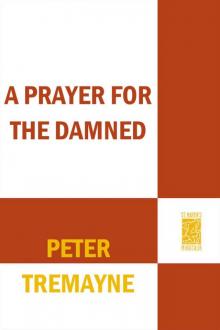 A Prayer for the Damned
A Prayer for the Damned Smoke in the Wind sf-11
Smoke in the Wind sf-11 An Ensuing Evil and Others
An Ensuing Evil and Others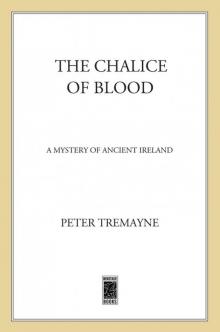 Chalice of Blood
Chalice of Blood